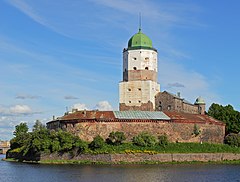Vyborg Castle
| Vyborg Castle | |
|---|---|
| Выборгский замок Viipurin linna Viborgs fästning |
|

View of the Vyborg Castle.
|
|
| General information | |
| Type | Medieval castle |
| Location | Vyborg, Leningrad Oblast, Russia |
| Coordinates | 60°42′57″N 28°43′45″E / 60.71583°N 28.72917°ECoordinates: 60°42′57″N 28°43′45″E / 60.71583°N 28.72917°E |
| Completed | 1290s |
Vyborg Castle (Russian: Выборгский замок, Finnish: Viipurin linna, Swedish: Viborgs fästning) is a Swedish-built medieval fortress around which the town of Viborg (today in Russia) evolved. Currently it serves as a museum.
Vyborg Castle was one of the three major castles of Finland. It was built as the easternmost outpost of the medieval Kingdom of Sweden: it is located on the Karelian Isthmus, on a little islet in the innermost corner of the Gulf of Finland, in a tight strait which connects Suomenvedenpohja to Bay of Viipuri. It was originally constructed in the 1290s.
The town was originally located inside the outer fortifications of the castle, at the fortress island, but it had to be moved to its present location out of the island because of lack of space.
V. A. Tjulanevs excavations in 1980`s indicated that a Karelian fortress pre-dated the castle built by the Swedes in 1293. The oldest layers of occupation have been discovered in the so called Smith`s Courtyard. A man-made breastwork of sand with timber posts was found from this area. Also charred remains of buildings, which some were linked to the breastwork, were also found. Tjulenev suggests that the Karelian fort had a wooden tower. Tjulanevs several finds from the area include a bent sword which was dated to the period between 1130-1200.
Construction of the next phase of the fortress started in 1293 by orders of Torkel Knutsson, Lord High Constable of Sweden, who in the 1290s made a supposed crusade against Karelia, the Third Finnish Crusade, which actually was aimed against the Russians of Novgorod Republic. Knutsson chose the location of the new fortress to control the Bay of Vyborg, which was bordered by trading sites long used by the local population. From the bay, a navigable river passage goes inland, ultimately connecting the place with several districts, lakes, and, indirectly by portage, with rivers flowing into Lake Ladoga.
...
Wikipedia
